Investigation: Cutting Transport Mechanism in Inclined Well Section under Pulsed Drilling Fluid Action
Abstract
:1. Introduction
2. Model Description
2.1. Theory
2.2. Boundary Conditions
3. Cuttings Transport Experiment of Pulsed Drilling Fluid in Inclined Well Section
3.1. Experiment Platform
- (1)
- The control valve was manipulated to control the centrifugal pump to transport drilling fluid from the liquid storage tank to the Plexiglas tube;
- (2)
- Once the flow of drilling fluid was stable, cuttings were added, the inner pipeline was rotated, and the trajectory of the cuttings was recorded with a high-speed camera;
- (3)
- The drilling fluid carried the cuttings away from the Plexiglas tube and flowed to the cuttings recycling pool. The filter separated the cuttings and the drilling fluid returned to the liquid storage tank;
- (4)
- The camera video was processed and converted into frame-by-frame images. The cut-tings transport time and position were determined accordingly, recorded, and used to calculate the time, velocity, and other relevant characteristics of the cuttings transport process.
3.2. Experimental Results and Discussion
3.2.1. Cuttings Flow Patterns
3.2.2. Impact of Various Cuttings Sizes
3.2.3. Impact of Various Drill Pipe Rotation Speeds
3.2.4. Impact of Different Cuttings Bed Mass
3.2.5. Impact of Various Well Wall Roughness Heights
3.3. Sensitivity Analysis of Pulse Parameters
4. Numerical Simulation
4.1. Numerical Model Validation
4.2. Pulse Parameter Sensitivity Analysis
5. Conclusions
Author Contributions
Funding
Institutional Review Board Statement
Data Availability Statement
Acknowledgments
Conflicts of Interest
Nomenclature
| Symbols | |
| CFD | Computational fluid dynamics |
| ROP | Rate of penetration |
| RPM | Revolutions per minute |
| Cross-section area | |
| Solids concentration | |
| Flow rate | |
| Velocity | |
| Entrainment rate | |
| Deposition rate | |
| Perimeter | |
| Solids packing porosity | |
| Density | |
| Pressure | |
| Shear stress | |
| Dimensionless coefficient | |
| Turbulent kinetic energy | |
| Specific dissipation rate | |
| Dissipation due to turbulence | |
| Effective diffusivity | |
| Generation due to mean velocity gradients | |
| Cross-diffusion term | |
| Velocity vector | |
| Interphase momentum transfer coefficient between solid and liquid phase | |
| Volume fraction | |
| Particle diameter | |
| Drag coefficient | |
| Viscosity | |
| Particles Reynolds number | |
| Interphase momentum transfer coefficient between solid and liquid phase | |
| Particles shape factor | |
| Drag force between liquid phase and solid phase of Huilin–Gidaspow model | |
| Interval between adjacent pulses | |
| Variation in the pulse from the minimum to the maximum | |
| Interval between two points along 0.5 at the leading edge and the trailing edge of the pulse | |
| Ratio of the pulse width to the value of pulse period minus the pulse width | |
| Maximum pulse value | |
| Subscripts | |
| Wellbore | |
| Solid phase | |
| Fluid phase | |
| Suspension layer | |
| Interface between uniform layer and dispersed layer | |
| Dispersed layer | |
| Uniform layer | |
| Slip between solid and liquid phase | |
| Interface between suspension layer and dispersed layer | |
| Interface between dispersed layer and uniform layer |
References
- Amanna, B.; Movaghar, M.R.K. Cuttings transport behavior in directional drilling using computational fluid dynamics (CFD). J. Nat. Gas Sci. Eng. 2016, 34, 670–679. [Google Scholar] [CrossRef]
- Li, J.; Luft, B. Overview Solids Transport Study and Application in Oil-Gas Industry-Theoretical Work. In Proceedings of the International Petroleum Technology Conference, Kuala Lumpur, Malaysia, 10–12 December 2014. [Google Scholar] [CrossRef]
- Zhang, F.; Miska, S.; Yu, M.; Ozbayoglu, E.M.; Takach, N. Pressure profile in annulus: Solids play a significant role. J. Energy Resour. Technol. 2015, 137, 064502. [Google Scholar] [CrossRef]
- Larsen, T.I.; Pilehvari, A.A.; Azar, J.J. Development of a new cuttings-transport model for high-angle wellbores including horizontal wells. SPE Drill. Complet. 1997, 12, 129–136. [Google Scholar] [CrossRef]
- Duan, M.; Miska, S.; Yu, M.; Takach, N.E.; Ahmed, R.M.; Zettner, C.M. Transport of small cuttings in extended-reach drilling. SPE Drill. Complet. 2008, 23, 258–265. [Google Scholar] [CrossRef]
- Shadizadeh, S.R.; Zoveidavianpoor, M. An experimental modeling of cuttings transport for an Iranian directional and horizontal well drilling. Pet. Sci. Technol. 2012, 30, 786–799. [Google Scholar] [CrossRef]
- Ghasemi Kafrudi, E.; Hashemabadi, S.H. Numerical Study on Effects of Drilling Mud Rheological Properties on the Transport of Drilling Cuttings. J. Energy Resour. Technol. 2016, 138, 012902. [Google Scholar] [CrossRef]
- Yu, M.; Takach, N.E.; Nakamura, D.R.; Shariff, M.M. An Experimental Study of Hole Cleaning under Simulated Downhole Conditions. In Proceedings of the SPE annual Technical Conference and Exhibition. Society of Petroleum Engineers, Anaheim, CA, USA, 11–14 November 2007. [Google Scholar] [CrossRef]
- Ozbayoglu, M.E.; Saasen, A.; Sorgun, M.; Svanes, K. Effect of pipe rotation on hole cleaning for water-based drilling fluids in horizontal and deviated wells. In Proceedings of the IADC/SPE Asia Pacific Drilling Technology Conference and Exhibition. Society of Petroleum Engineers, Jakarta, Indonesia, 25–27 August 2008. [Google Scholar] [CrossRef]
- Sorgun, M.; Aydin, I.; Ozbayoglu, M.E. Friction factors for hydraulic calculations considering presence of cuttings and pipe rotation in horizontal/highly-inclined wellbores. J. Pet. Sci. Eng. 2011, 78, 407–414. [Google Scholar] [CrossRef]
- Ofei, T.N.; Yaaqob, S.Y. Numerical simulation of transport behaviour of small cuttings in extended reach wells. Int. J. Oil Gas Coal Technol. 2019, 21, 149–168. [Google Scholar] [CrossRef]
- Piroozian, A.; Ismail, I.; Yaacob, Z.; Babakhani, P.; Ismail, A.S.I. Impact of drilling fluid viscosity, velocity and hole inclination on cuttings transport in horizontal and highly deviated wells. J. Pet. Explor. Prod. Technol. 2012, 2, 149–156. [Google Scholar] [CrossRef]
- Kim, Y.J.; Woo, N.S.; Hwang, Y.K.; Kim, J.H.; Han, S.M. Transport of small cuttings in solid-liquid flow with inclined slim hole annulus. J. Mech. Sci. Technol. 2014, 28, 115–126. [Google Scholar] [CrossRef]
- Cho, H.; Shah, S.N.; Osisanya, S.O. A three-segment hydraulic model for cuttings transport in coiled tubing horizontal and deviated drilling. J. Can. Pet. Technol. 2002, 41. [Google Scholar] [CrossRef]
- Ramadan, A.; Skalle, P.; Saasen, A. Application of a three-layer modeling approach for solids transport in horizontal and inclined channels. Chem. Eng. Sci. 2005, 60, 2557–2570. [Google Scholar] [CrossRef]
- Guo, X.L.; Wang, Z.M.; Long, Z.H. Study on three-layer unsteady model of cuttings transport for extended-reach well. J. Pet. Sci. Eng. 2010, 73, 171–180. [Google Scholar] [CrossRef]
- Zhang, F.; Miska, S.; Yu, M.; Ozbayoglu, E. A unified transient solid-liquid two-phase flow model for cuttings transport-modelling part. J. Pet. Sci. Eng. 2018, 166, 146–156. [Google Scholar] [CrossRef]
- Han, S.M.; Hwang, Y.K.; Woo, N.S.; Kim, Y.J. Solid–liquid hydrodynamics in a slim hole drilling annulus. J. Pet. Sci. Eng. 2010, 70, 308–319. [Google Scholar] [CrossRef]
- Ofei, T.N.; Irawan, S.; Pao, W. CFD method for predicting annular pressure losses and cuttings concentration in eccentric horizontal wells. J. Pet. Eng. 2014. [CrossRef] [Green Version]
- Sun, X.; Wang, K.; Yan, T.; Shao, S.; Jiao, J. Effect of drillpipe rotation on cuttings transport using computational fluid dynamics (CFD) in complex structure wells. J. Pet. Explor. Prod. Technol. 2014, 4, 255–261. [Google Scholar] [CrossRef] [Green Version]
- Akhshik, S.; Behzad, M.; Rajabi, M. CFD–DEM approach to investigate the effect of drill pipe rotation on cuttings transport behavior. J. Petrol. Sci. Eng. 2015, 127, 229–244. [Google Scholar] [CrossRef]
- Heydari, O.; Sahraei, E.; Skalle, P. Investigating the impact of drillpipe’s rotation and eccentricity on cuttings transport phenomenon in various horizontal annuluses using computational fluid dynamics (CFD). J. Pet. Sci. Eng. 2017, 156, 801–813. [Google Scholar] [CrossRef]
- Epelle, E.I.; Gerogiorgis, D.I. Transient and steady state analysis of drill cuttings transport phenomena under turbulent conditions. Chem. Eng. Res. Des. 2017, 131, 520–544. [Google Scholar] [CrossRef] [Green Version]
- Ozbayoglu, M.E.; Saasen, A.; Sorgun, M.; Svanes, K. Critical fluid velocities for removing cuttings bed inside horizontal and deviated wells. Pet. Sci. Technol. 2010, 28, 594–602. [Google Scholar] [CrossRef]
- Wang, R.H.; Du, Y.K.; Ni, H.J.; Ma, L. Hydrodynamic analysis of suck-in pulsed jetin well drilling. J. Hydrodyn. 2011, 23, 34–41. [Google Scholar] [CrossRef]
- Shi, H.; Li, G.; Guo, B.; He, Z. Hydraulic pulse jet: Test of characteristics and field applications in ultra-deep wells. J. Nat. Gas Sci. Eng. 2015, 27, 200–206. [Google Scholar] [CrossRef]
- Hongna, Q.U.; Gensheng, L.I.; Jiang, D. Mechanisms and Application for Hydraulic Pulsed Cavitating Jet Generator. Adv. Pet. Exp. Dev. 2016, 12, 1–12. [Google Scholar] [CrossRef]
- Li, G.; Shi, H.; Liao, H.; Shen, Z.; Niu, J.; Huang, Z.; Luo, H. Hydraulic pulsed cavitating jet-assisted drilling. Pet. Sci. Technol. 2009, 27, 197–207. [Google Scholar] [CrossRef]
- Li, G.; Shi, H.; Niu, J.; Huang, Z.; Tian, S.; Song, X. Hydraulic Pulsed Cavitating Jet Assisted Deep Drilling: An Approach to Improve Rate of Penetration. In Proceedings of the International Oil and Gas Conference and Exhibition in China. Society of Petroleum Engineers, Beijing, China, 8–10 June 2010. [Google Scholar] [CrossRef]
- Shi, H.; Li, G.; Huang, Z.; Shi, S. Properties and testing of a hydraulic pulse jet and its application in offshore drilling. Pet. Sci. 2014, 11, 401–407. [Google Scholar] [CrossRef] [Green Version]
- Fu, J.; Li, G.; Shi, H.; Niu, J.; Huang, Z. 2012 A novel tool to improve the rate of penetration--hydraulic-pulsed cavitating-jet generator. SPE Drill. Complet. 2012, 27, 355–362. [Google Scholar] [CrossRef]
- Cheng, R.; Ge, Y.; Wang, H.; Ni, H.; Zhang, H.; Sun, Q. Self-Oscillation Pulsed Percussive Rotary Tool Enhances Drilling Through Hard Igneous Formations. In Proceedings of the IADC/SPE Asia Pacific Drilling Technology Conference and Exhibition. Society of Petroleum Engineers, Tianjin, China, 9–11 July 2012. [Google Scholar] [CrossRef]
- Cui, L.; Zhang, F.; Wang, H.; Ge, Y.; Zhuo, L.; Li, H. Development and Application of Adjustable Frequency Pulse Jet Generating Tool to Improve Rate of Penetration in Deep Wells. In Proceedings of the IADC/SPE Asia Pacific Drilling Technology Conference and Exhibition, Tianjin, China, 9–11 July 2012. [Google Scholar]
- Wang, M.; He, J.; He, Y.; Xu, Y.; Zhao, J. Application of Down-hole Screw-type Pressure Intensifier for ROP Enhancement. In Proceedings of the IADC/SPE Asia Pacific Drilling Technology Conference and Exhibition, Tianjin, China, 9–11 July 2012. [Google Scholar]
- Shakib, J.T.; Ghaderi, A.; Shahri, A.A. 2012 Analysis of hydraulic fracturing length and aperture on the production rate in fractured reservoir. Resuscitation 2015, 96, 180–185. [Google Scholar] [CrossRef] [Green Version]
- Shakib, J.T.; Ghaderi, A.; Shahri, A.A. Analysis of hydraulic fracturing in fractured reservoir: Interaction between hydraulic fracture and natural fractures. Science 1988, 239, 1313. [Google Scholar] [CrossRef] [Green Version]
- Pang, B.; Wang, S.; Liu, G.; Jiang, X.; Lu, H.; Li, Z. Numerical prediction of flow behavior of cuttings carried by Herschel-Bulkley fluids in horizontal well using kinetic theory of granular flow. Powder Technol. 2018, 329, 386–398. [Google Scholar] [CrossRef]
- Akhshik, S.; Behzad, M.; Rajabi, M. CFD-DEM simulation of the hole cleaning process in a deviated well drilling: The effects of particle shape. Particuology 2016, 25, 72–82. [Google Scholar] [CrossRef]
- Sifferman, T.R.; Becker, T.E. Hole Cleaning in Full-Scale Inclined Wellbores. SPE Drill. Eng. 1992, 7, 115–120. [Google Scholar] [CrossRef]
- Zhu, X.H.; Shen, K.Y.; Li, B.; Lv, Y.X. Cuttings Transport Using Pulsed Drilling Fluid in the Horizontal Section of the Slim-Hole: An Experimental and Numerical Simulation Study. Energies 2019, 12, 3939. [Google Scholar] [CrossRef] [Green Version]
- Zhu, X.H.; Sun, C.; Tong, H. Distribution features, transport mechanism and destruction of cuttings bed in horizontal well. J. Hydrodyn. 2013, 25, 628–638. [Google Scholar] [CrossRef]
- Jia, Y.J.; Tong, H. Structure security analysis of cuttings falling-prevention tool for gas drilling. China Petrol. Mach. 2009, 37, 9–11, 89. [Google Scholar] [CrossRef]
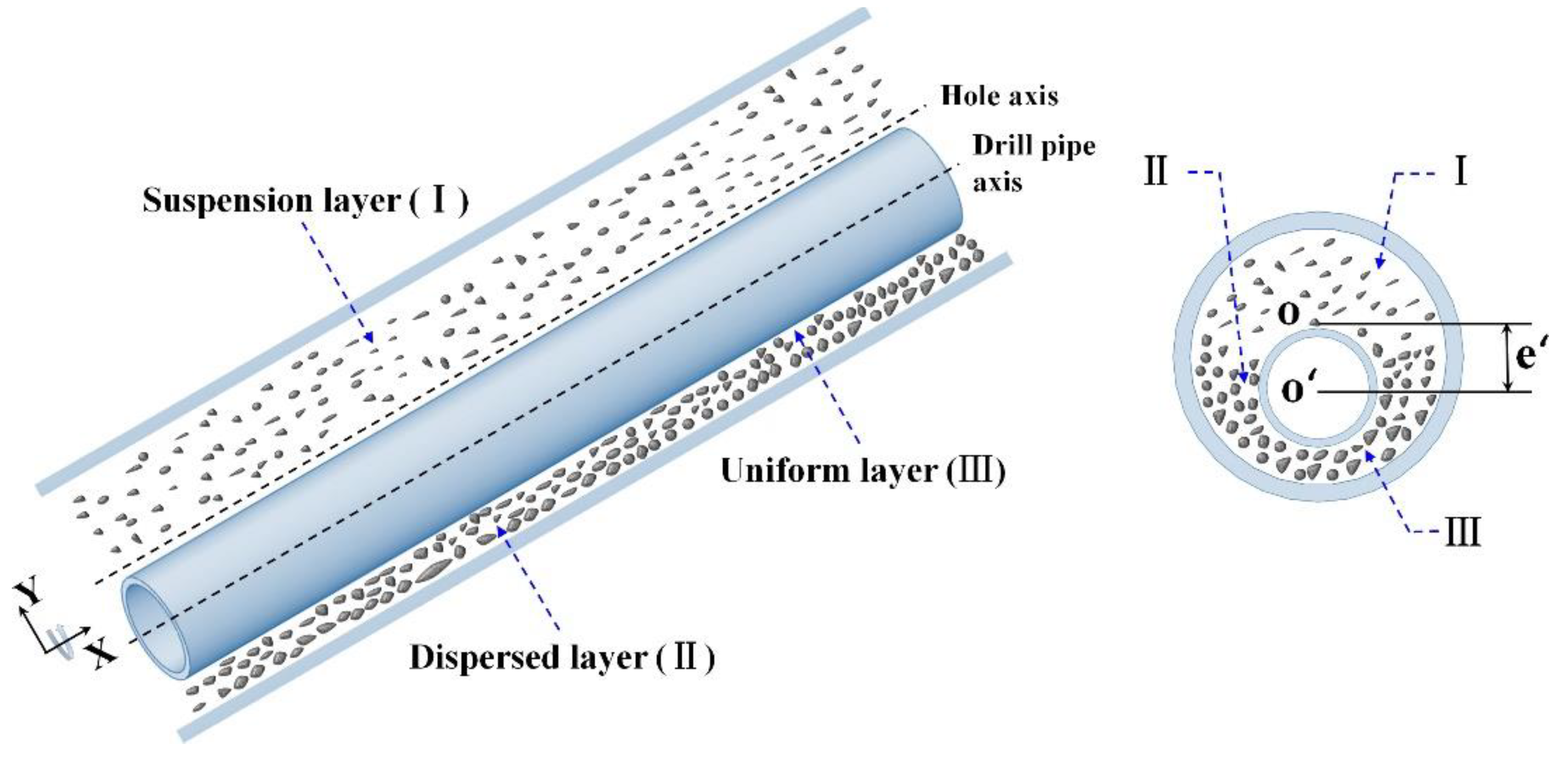
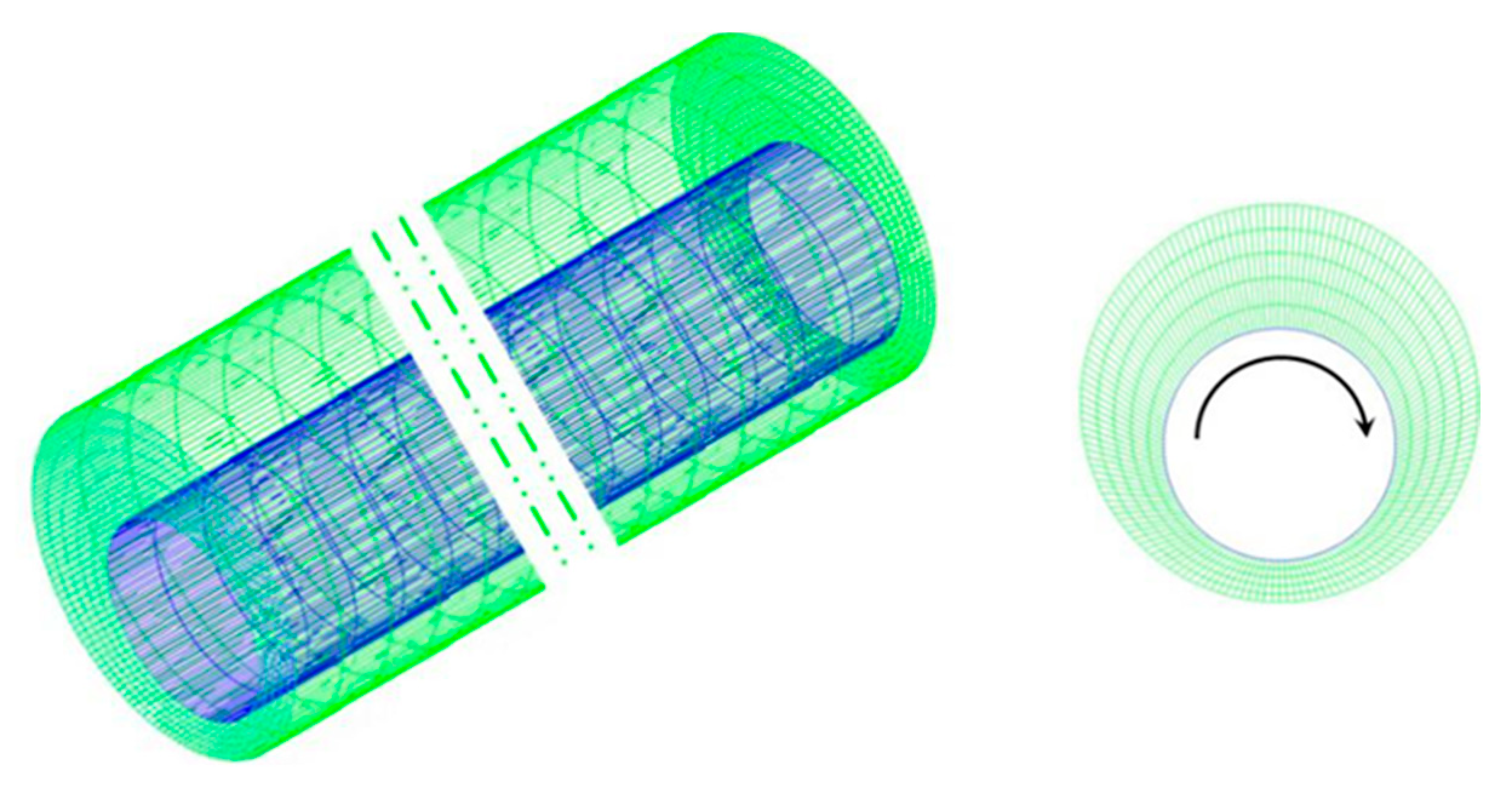

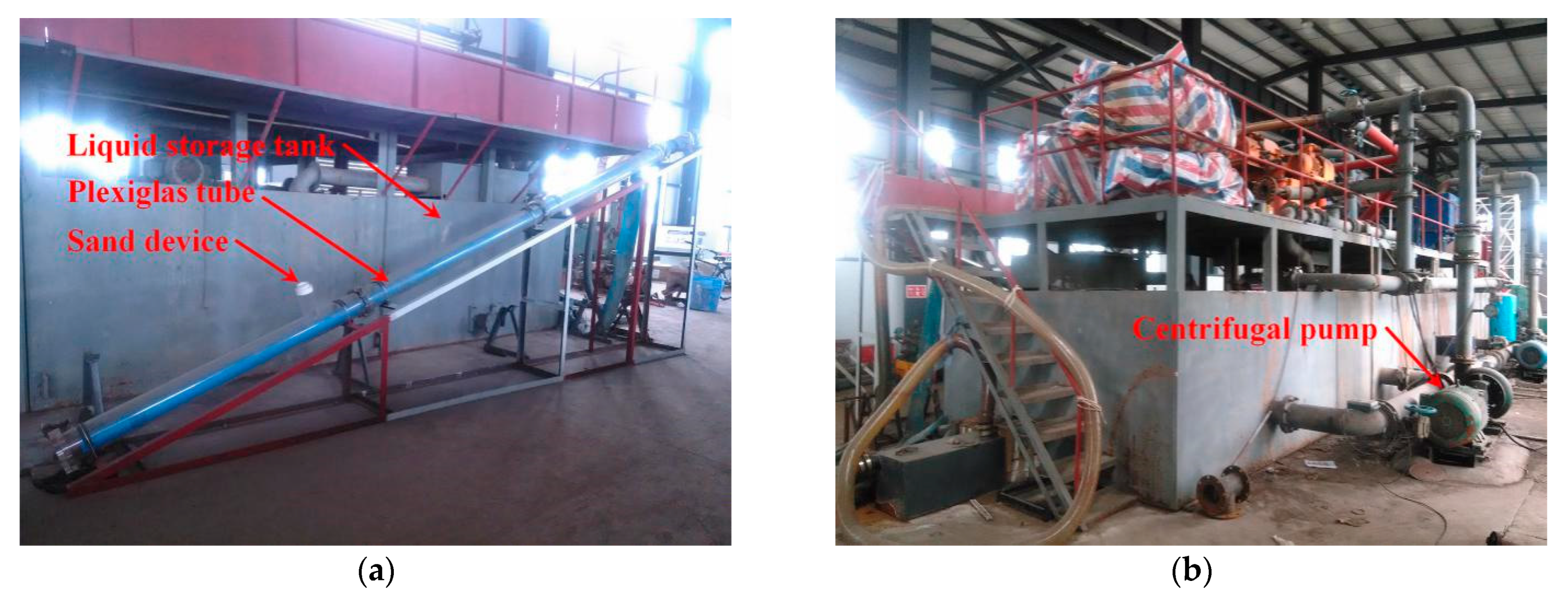

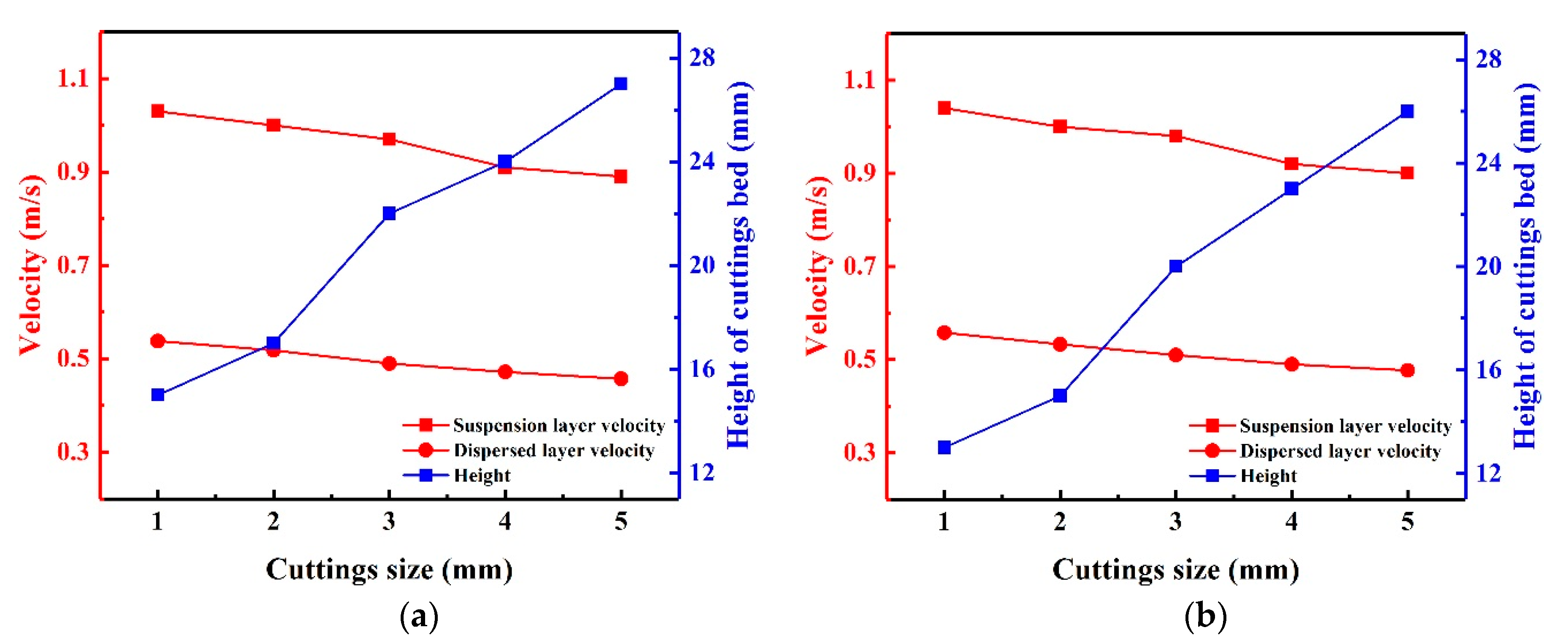

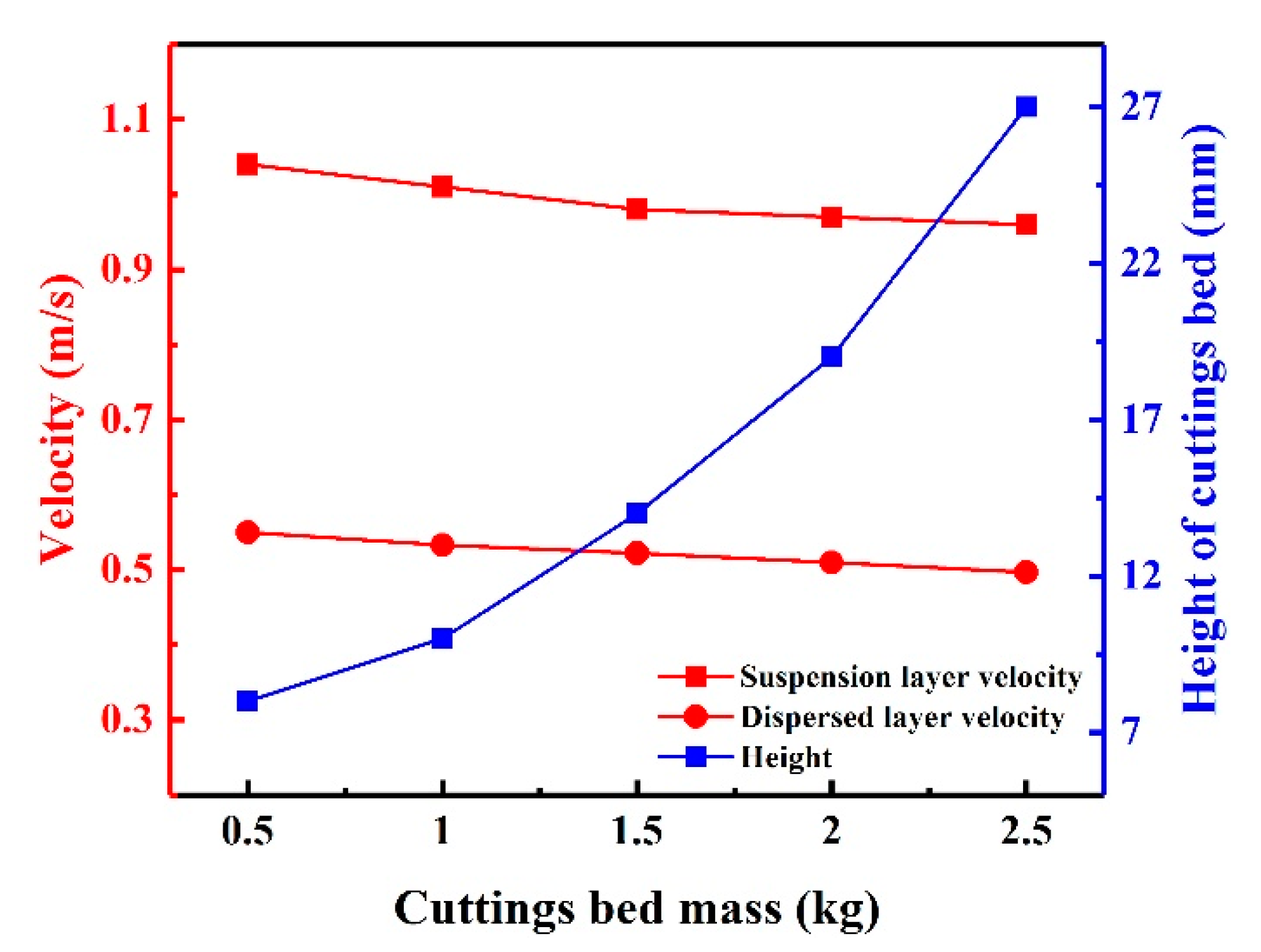



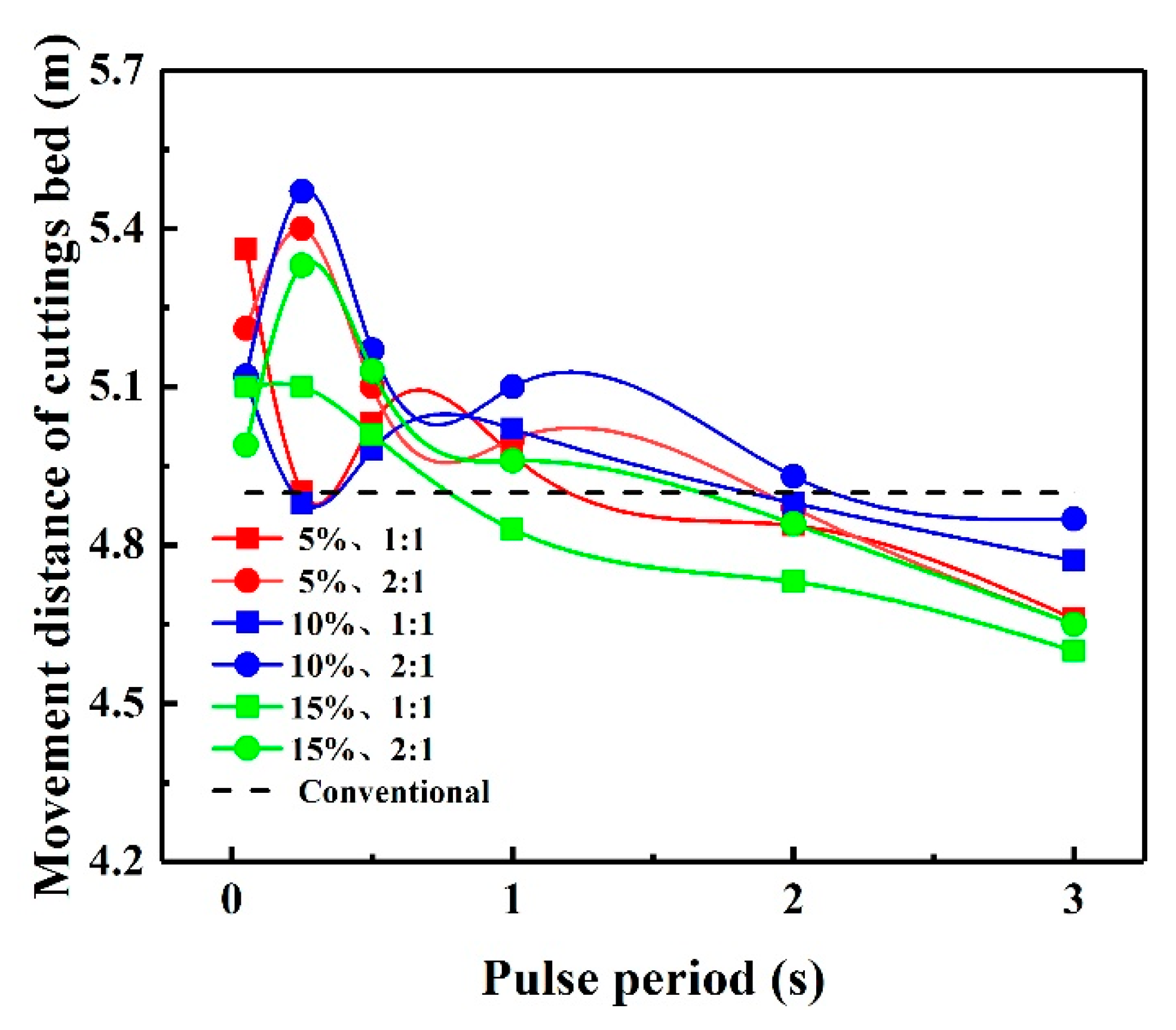
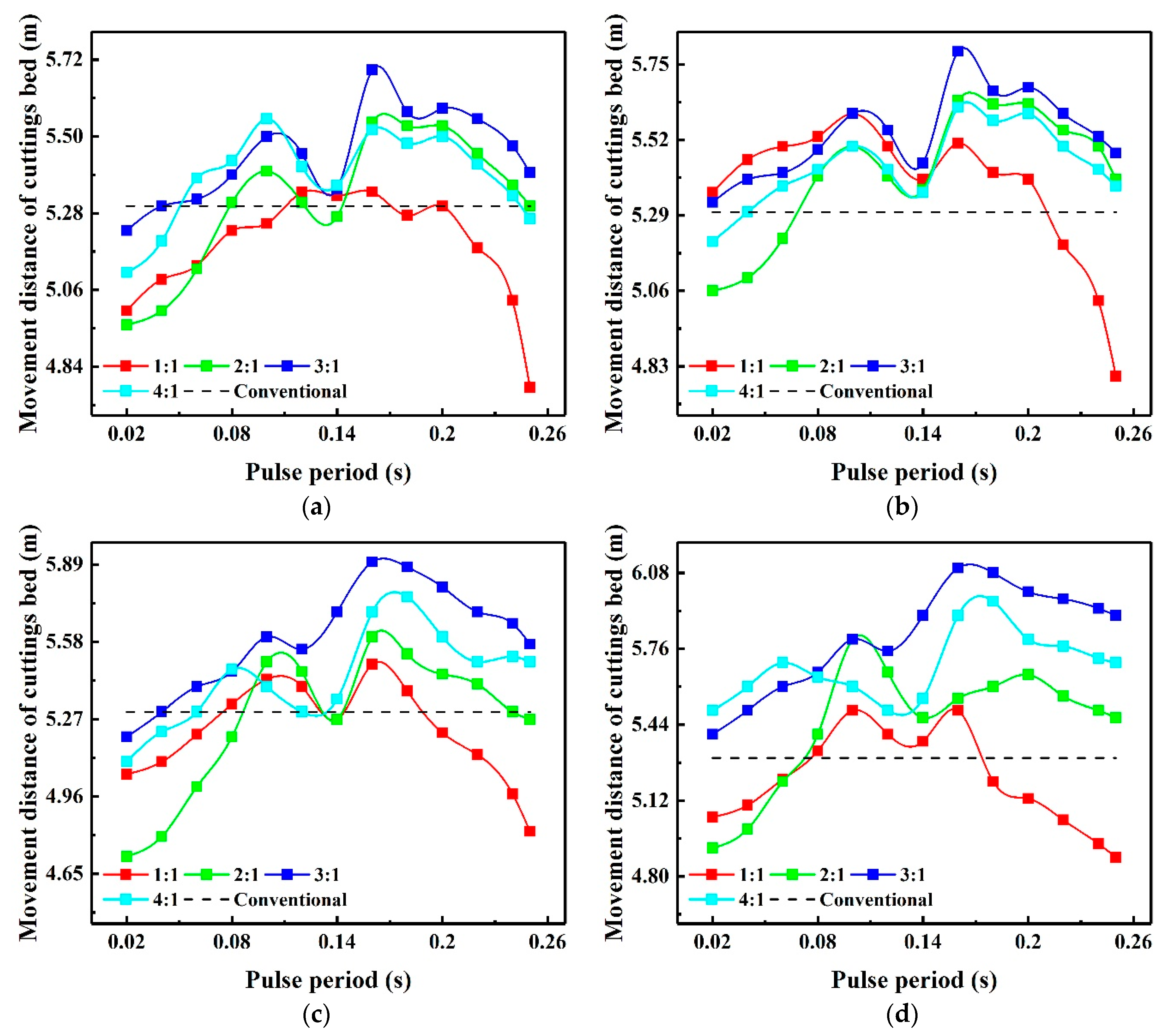
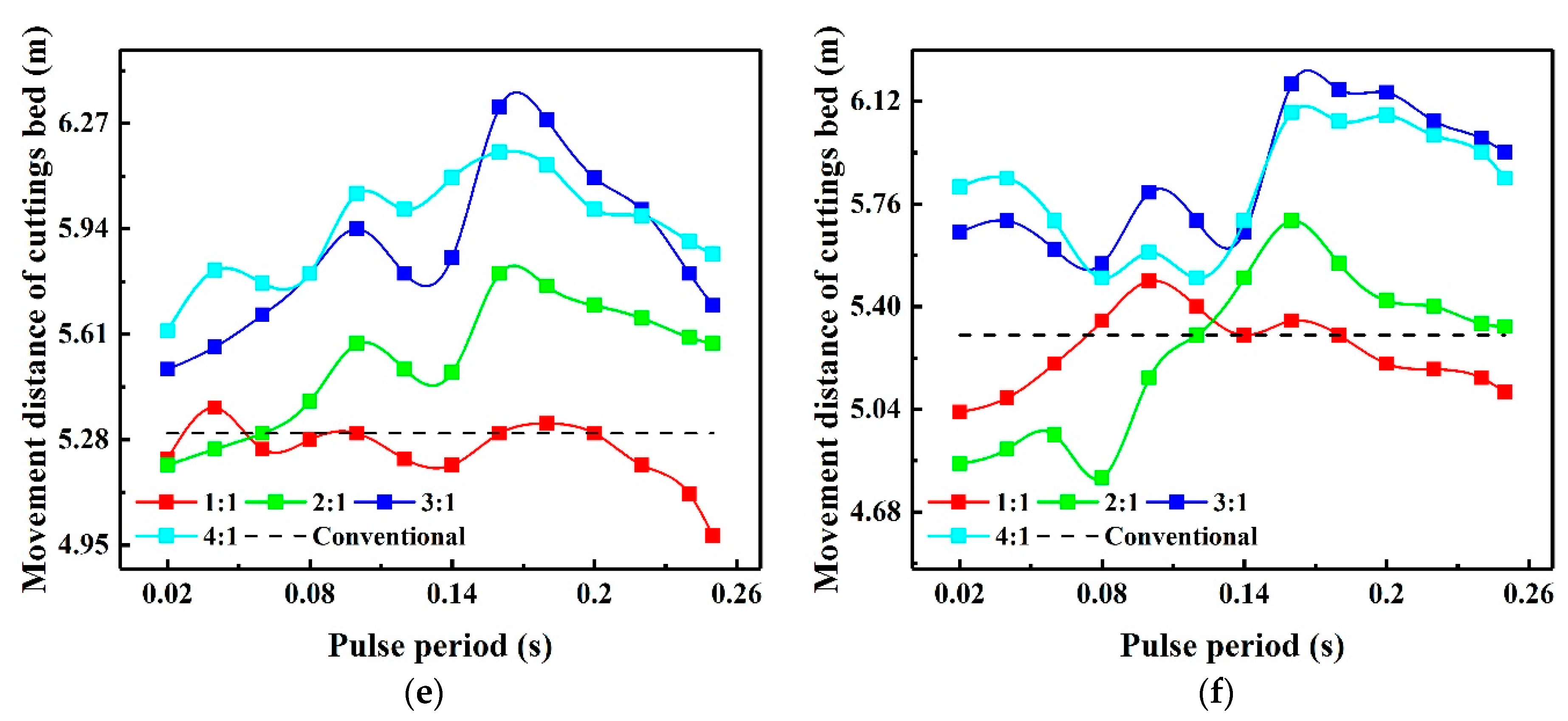
| Parameter | Simulation Value | Units |
|---|---|---|
| Drill pipe diameter | 88.9 | mm |
| Annulus diameter | 152.4 | mm |
| Hole deviation angle | 60 | degree |
| Drill pipe rotation speed | 0, 60, 120, 180 | rpm |
| Drilling fluid density | 1200 | kg/m3 |
| Particle density | 2600 | kg/m3 |
| Particle diameter | 1, 2, 3, 4, 5 | mm |
| Cuttings bed mass | 0.25, 0.5, 1, 1.5, 2 | kg |
| Roughness height | 0, 1, 3, 5 | mm |
| Parameter | Simulation Value | Units |
|---|---|---|
| Pulse amplitude ratios | 0, 5, 10, 15 | % |
| Pulse periods (T) | 1, 2, 3 | s |
| Duty cycles (q) | 1:1, 2:1 |
| Parameter | Simulation Value | Units |
|---|---|---|
| Pulse amplitude ratios | 0, 2.5, 5, 7.5, 10, 12.5, 15 | % |
| Pulse periods (T) | 0.02–0.25 | s |
| Duty cycles (q) | 1:1, 2:1, 3:1, 4:1 |
Publisher’s Note: MDPI stays neutral with regard to jurisdictional claims in published maps and institutional affiliations. |
© 2021 by the authors. Licensee MDPI, Basel, Switzerland. This article is an open access article distributed under the terms and conditions of the Creative Commons Attribution (CC BY) license (https://creativecommons.org/licenses/by/4.0/).
Share and Cite
Zhu, X.; Shen, K.; Li, B. Investigation: Cutting Transport Mechanism in Inclined Well Section under Pulsed Drilling Fluid Action. Energies 2021, 14, 2141. https://doi.org/10.3390/en14082141
Zhu X, Shen K, Li B. Investigation: Cutting Transport Mechanism in Inclined Well Section under Pulsed Drilling Fluid Action. Energies. 2021; 14(8):2141. https://doi.org/10.3390/en14082141
Chicago/Turabian StyleZhu, Xiaohua, Keyu Shen, and Bo Li. 2021. "Investigation: Cutting Transport Mechanism in Inclined Well Section under Pulsed Drilling Fluid Action" Energies 14, no. 8: 2141. https://doi.org/10.3390/en14082141





